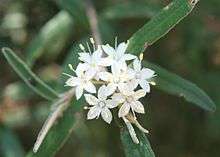Phebalium daviesii
Phebalium daviesii, commonly known as St Helens wax flower[2] or Davies' wax flower,[3] is a species of shrub that is endemic to a restricted area in Tasmania. It is more or less covered with silvery or rust-coloured scales and has narrow wedge-shaped leaves with a notched tip, and umbels of white to cream-coloured, five-petalled flowers.
| St Helens wax flower | |
|---|---|
 | |
| Scientific classification | |
| Kingdom: | Plantae |
| Clade: | Tracheophytes |
| Clade: | Angiosperms |
| Clade: | Eudicots |
| Clade: | Rosids |
| Order: | Sapindales |
| Family: | Rutaceae |
| Genus: | Phebalium |
| Species: | P. daviesii |
| Binomial name | |
| Phebalium daviesii | |
Description
Phebalium daviesii is a shrub that grows to a height of 1–3 m (3 ft 3 in–9 ft 10 in) and is more or less covered with silvery or rust-coloured scales. The leaves are narrow wedge-shaped, up to 20 mm (0.79 in) long and 1–3 mm (0.039–0.118 in) wide with a notched tip, a short petiole and glabrous on the upper surface. The flowers are white to cream-coloured and arranged in sessile umbels on the ends of branchlets, each flower on a pedicel about 4 mm (0.16 in) long. The sepals are joined to form a hemispherical calyx 1–1.5 mm (0.039–0.059 in) long and 2 mm (0.079 in) wide with triangular lobes. The five petals are broadly elliptical, about 3 mm (0.12 in) long and 2 mm (0.079 in) wide. Flowering occurs from September to November.[2][3][4][5]
Taxonomy
Phebalium daviesii was first formally described in 1859 by Joseph Dalton Hooker and the description was published in The botany of the Antarctic voyage of H.M. Discovery ships Erebus and Terror. III. Flora Tasmaniae.[6][7]
Distribution and habitat
St Helens wax flower is only found in a small area along 4.5 km (2.8 mi) of the George River near St. Helens on Tasmania's north-east coast. It grows in Eucalyptus viminalis woodland with a heathy understorey.[5][3]
Conservation status
This phebalium is listed as "critically endangered" under the Australian Government Environment Protection and Biodiversity Conservation Act 1999 and a recovery plan has been prepared. It was assumed to be extinct, having not been collected since 1892, until it was rediscovered in 1990, although in 2001, only 23 mature individuals were recorded. The main threats to the species are its small population size, damage caused by flooding and susceptibility to Phytophthora cinnamomi fungus.[3][8]
Use in horticulture
St Helens wax flower can be readily grown from cuttings and has been propagated in several plant nurseries.[2]
Culture
In 2001, each Australian state nominated a native flower as a floral emblem to celebrate the centenary of the Federation of Australia. The St Helens wax flower was chosen as the Tasmanian Federation Flower.[2]
References
- "Phebalium daviesii". Australian Plant Census. Retrieved 16 June 2020.
- "Federation Flower for Tasmania". Australian National Botanic Gardens. Retrieved 16 June 2020.
- "Threatened Species Listing Statement - Davies' wax flower, Phebalium daviesii". Tasmanian Government Department of Primary Industries, Parks, Water and Environment. Retrieved 17 June 2020.
- Wilson, Paul G. (1970). "A Taxonomic Revision of the Genera Crowea, Eriostemon and Phebalium (Rutaceae). Nuytsia 1(1):". Nuytsia. 1 (1): 87. Retrieved 16 June 2020.
- Wilson, Paul G. "Phebalium daviesii". Australian Biological Resources Study, Department of Agriculture, Water and the Environment, Canberra. Retrieved 17 June 2020.
- "Phebalium daviesii". APNI. Retrieved 17 June 2020.
- Hooker, Joseph Dalton (1859). The botany of the Antarctic voyage of H.M. discovery ships Erebus and Terror in the Years 1839-1843 :under the command of Captain Sir James Clark Ross /. London: Lovell Reeve. p. 358. Retrieved 17 June 2020.
- "Phebalium daviesii Flora Recovery Plan" (PDF). Australian Government Department of the Environment. Retrieved 17 June 2020.
